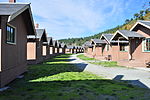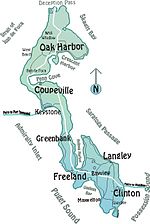Camano Island

Camano Island is a large island in Possession Sound, a section of Puget Sound. It is part of Island County, Washington, and is located between Whidbey Island and the mainland (Snohomish County) by the Saratoga Passage to the west and Port Susan and Davis Slough to the east. The island has one road connection to the mainland, via State Route 532 over the Camano Gateway Bridge at the northeast end of the island, connecting to the city of Stanwood. The island has a total area of 39.77 square miles (103.0 km2), making it one of the largest in the state of Washington. It has a year-round population of 15,661 as of the 2010 census. The population peaks at over 17,000 during the summer months due to part-time residents with vacation homes on the island. It is an unincorporated area with several small communities and shares civic facilities with nearby Stanwood, including its school district, and post office. Camano Island is home to two state parks, Cama Beach and Camano Island State Park, and several county and local parks.
Excerpt from the Wikipedia article Camano Island (License: CC BY-SA 3.0, Authors, Images).Camano Island
West Camano Hill Road,
Geographical coordinates (GPS) Address Nearby Places Show on map
Geographical coordinates (GPS)
| Latitude | Longitude |
|---|---|
| N 48.186239 ° | E -122.507697 ° |
Address
West Camano Hill Road 690
98282
Washington, United States
Open on Google Maps






